BSc Business Management: Business Law Report for IOM Solutions
VerifiedAdded on 2023/06/10
|8
|2447
|139
Report
AI Summary
This report, prepared for a BSc in Business Management, examines the legal context for business organizations in the UK, using IOM Solutions as a case study. It begins with an introduction to business law, outlining its significance and scope, and then explores the different types of business entities available in the UK, including sole traders, general partnerships, limited partnerships, and limited liability partnerships. The report details the legal implications, advantages, and disadvantages of each structure. Furthermore, the report analyzes the specific context of IOM Solutions, a company selling electrical parts, and provides a recommendation for the most suitable legal structure for the business. The report concludes with a summary of the key findings and a list of references.
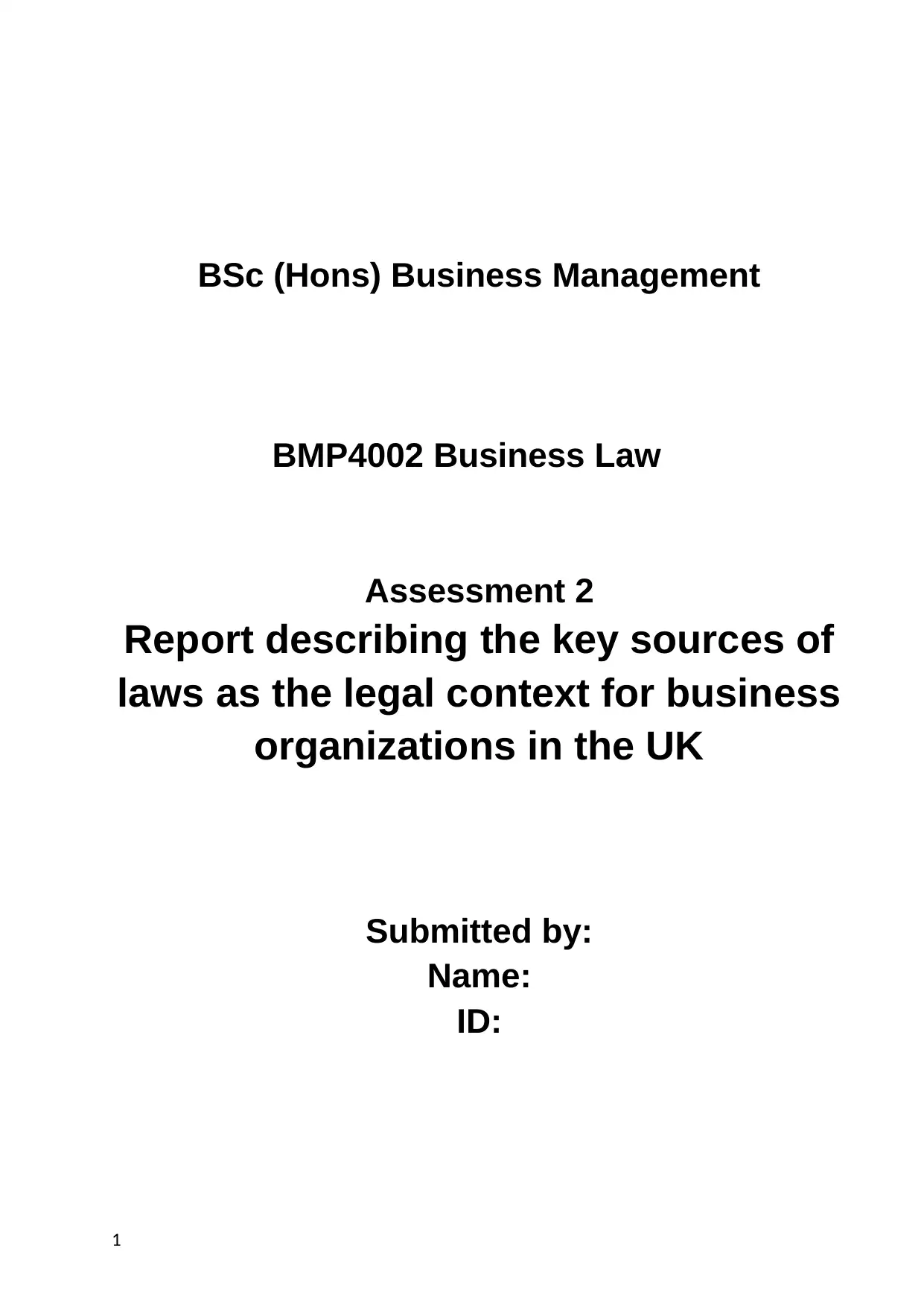
BSc (Hons) Business Management
BMP4002 Business Law
Assessment 2
Report describing the key sources of
laws as the legal context for business
organizations in the UK
Submitted by:
Name:
ID:
1
BMP4002 Business Law
Assessment 2
Report describing the key sources of
laws as the legal context for business
organizations in the UK
Submitted by:
Name:
ID:
1
Paraphrase This Document
Need a fresh take? Get an instant paraphrase of this document with our AI Paraphraser
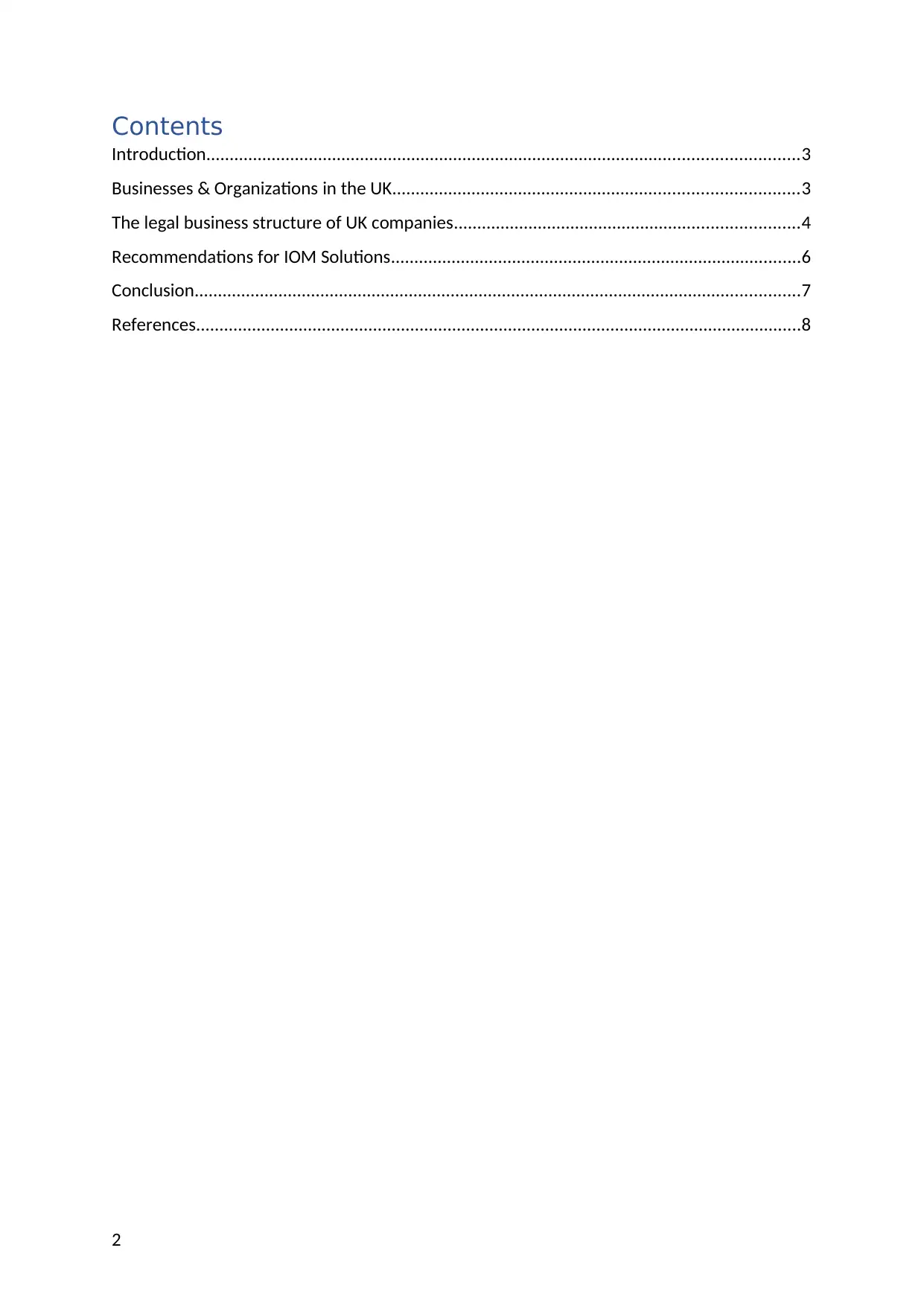
Contents
Introduction...............................................................................................................................3
Businesses & Organizations in the UK.......................................................................................3
The legal business structure of UK companies..........................................................................4
Recommendations for IOM Solutions........................................................................................6
Conclusion..................................................................................................................................7
References..................................................................................................................................8
2
Introduction...............................................................................................................................3
Businesses & Organizations in the UK.......................................................................................3
The legal business structure of UK companies..........................................................................4
Recommendations for IOM Solutions........................................................................................6
Conclusion..................................................................................................................................7
References..................................................................................................................................8
2
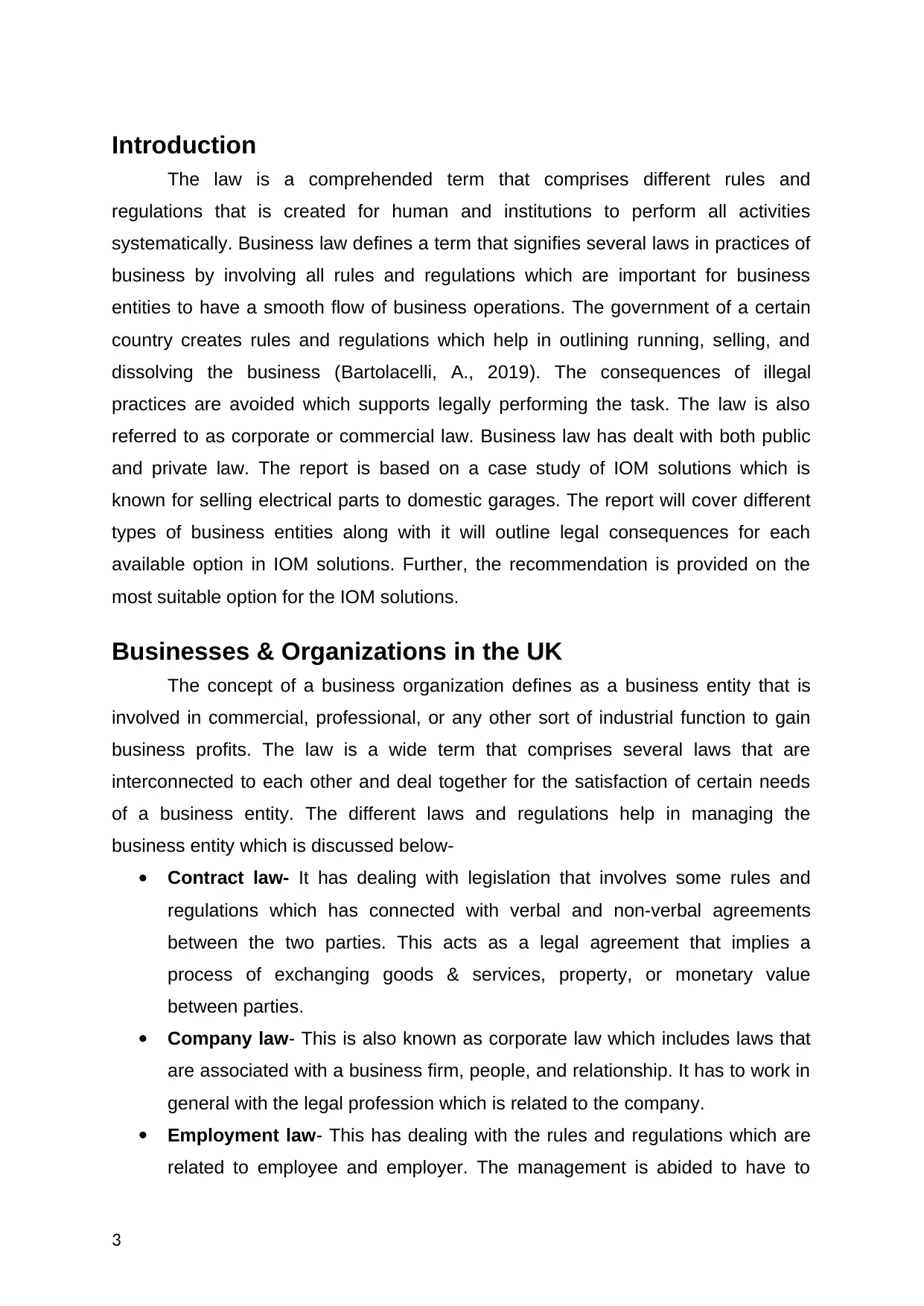
Introduction
The law is a comprehended term that comprises different rules and
regulations that is created for human and institutions to perform all activities
systematically. Business law defines a term that signifies several laws in practices of
business by involving all rules and regulations which are important for business
entities to have a smooth flow of business operations. The government of a certain
country creates rules and regulations which help in outlining running, selling, and
dissolving the business (Bartolacelli, A., 2019). The consequences of illegal
practices are avoided which supports legally performing the task. The law is also
referred to as corporate or commercial law. Business law has dealt with both public
and private law. The report is based on a case study of IOM solutions which is
known for selling electrical parts to domestic garages. The report will cover different
types of business entities along with it will outline legal consequences for each
available option in IOM solutions. Further, the recommendation is provided on the
most suitable option for the IOM solutions.
Businesses & Organizations in the UK
The concept of a business organization defines as a business entity that is
involved in commercial, professional, or any other sort of industrial function to gain
business profits. The law is a wide term that comprises several laws that are
interconnected to each other and deal together for the satisfaction of certain needs
of a business entity. The different laws and regulations help in managing the
business entity which is discussed below-
Contract law- It has dealing with legislation that involves some rules and
regulations which has connected with verbal and non-verbal agreements
between the two parties. This acts as a legal agreement that implies a
process of exchanging goods & services, property, or monetary value
between parties.
Company law- This is also known as corporate law which includes laws that
are associated with a business firm, people, and relationship. It has to work in
general with the legal profession which is related to the company.
Employment law- This has dealing with the rules and regulations which are
related to employee and employer. The management is abided to have to
3
The law is a comprehended term that comprises different rules and
regulations that is created for human and institutions to perform all activities
systematically. Business law defines a term that signifies several laws in practices of
business by involving all rules and regulations which are important for business
entities to have a smooth flow of business operations. The government of a certain
country creates rules and regulations which help in outlining running, selling, and
dissolving the business (Bartolacelli, A., 2019). The consequences of illegal
practices are avoided which supports legally performing the task. The law is also
referred to as corporate or commercial law. Business law has dealt with both public
and private law. The report is based on a case study of IOM solutions which is
known for selling electrical parts to domestic garages. The report will cover different
types of business entities along with it will outline legal consequences for each
available option in IOM solutions. Further, the recommendation is provided on the
most suitable option for the IOM solutions.
Businesses & Organizations in the UK
The concept of a business organization defines as a business entity that is
involved in commercial, professional, or any other sort of industrial function to gain
business profits. The law is a wide term that comprises several laws that are
interconnected to each other and deal together for the satisfaction of certain needs
of a business entity. The different laws and regulations help in managing the
business entity which is discussed below-
Contract law- It has dealing with legislation that involves some rules and
regulations which has connected with verbal and non-verbal agreements
between the two parties. This acts as a legal agreement that implies a
process of exchanging goods & services, property, or monetary value
between parties.
Company law- This is also known as corporate law which includes laws that
are associated with a business firm, people, and relationship. It has to work in
general with the legal profession which is related to the company.
Employment law- This has dealing with the rules and regulations which are
related to employee and employer. The management is abided to have to
3
⊘ This is a preview!⊘
Do you want full access?
Subscribe today to unlock all pages.

Trusted by 1+ million students worldwide
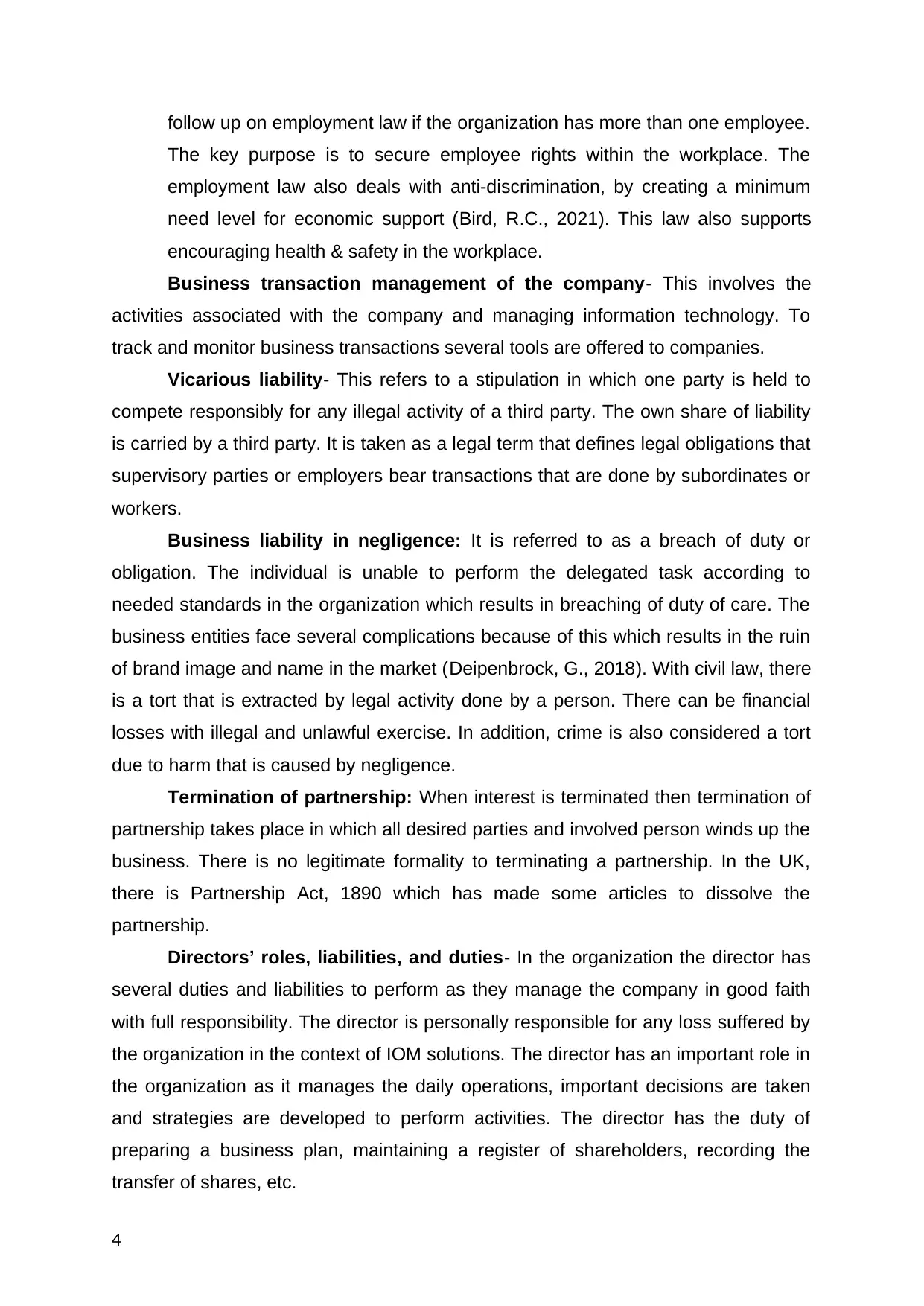
follow up on employment law if the organization has more than one employee.
The key purpose is to secure employee rights within the workplace. The
employment law also deals with anti-discrimination, by creating a minimum
need level for economic support (Bird, R.C., 2021). This law also supports
encouraging health & safety in the workplace.
Business transaction management of the company- This involves the
activities associated with the company and managing information technology. To
track and monitor business transactions several tools are offered to companies.
Vicarious liability- This refers to a stipulation in which one party is held to
compete responsibly for any illegal activity of a third party. The own share of liability
is carried by a third party. It is taken as a legal term that defines legal obligations that
supervisory parties or employers bear transactions that are done by subordinates or
workers.
Business liability in negligence: It is referred to as a breach of duty or
obligation. The individual is unable to perform the delegated task according to
needed standards in the organization which results in breaching of duty of care. The
business entities face several complications because of this which results in the ruin
of brand image and name in the market (Deipenbrock, G., 2018). With civil law, there
is a tort that is extracted by legal activity done by a person. There can be financial
losses with illegal and unlawful exercise. In addition, crime is also considered a tort
due to harm that is caused by negligence.
Termination of partnership: When interest is terminated then termination of
partnership takes place in which all desired parties and involved person winds up the
business. There is no legitimate formality to terminating a partnership. In the UK,
there is Partnership Act, 1890 which has made some articles to dissolve the
partnership.
Directors’ roles, liabilities, and duties- In the organization the director has
several duties and liabilities to perform as they manage the company in good faith
with full responsibility. The director is personally responsible for any loss suffered by
the organization in the context of IOM solutions. The director has an important role in
the organization as it manages the daily operations, important decisions are taken
and strategies are developed to perform activities. The director has the duty of
preparing a business plan, maintaining a register of shareholders, recording the
transfer of shares, etc.
4
The key purpose is to secure employee rights within the workplace. The
employment law also deals with anti-discrimination, by creating a minimum
need level for economic support (Bird, R.C., 2021). This law also supports
encouraging health & safety in the workplace.
Business transaction management of the company- This involves the
activities associated with the company and managing information technology. To
track and monitor business transactions several tools are offered to companies.
Vicarious liability- This refers to a stipulation in which one party is held to
compete responsibly for any illegal activity of a third party. The own share of liability
is carried by a third party. It is taken as a legal term that defines legal obligations that
supervisory parties or employers bear transactions that are done by subordinates or
workers.
Business liability in negligence: It is referred to as a breach of duty or
obligation. The individual is unable to perform the delegated task according to
needed standards in the organization which results in breaching of duty of care. The
business entities face several complications because of this which results in the ruin
of brand image and name in the market (Deipenbrock, G., 2018). With civil law, there
is a tort that is extracted by legal activity done by a person. There can be financial
losses with illegal and unlawful exercise. In addition, crime is also considered a tort
due to harm that is caused by negligence.
Termination of partnership: When interest is terminated then termination of
partnership takes place in which all desired parties and involved person winds up the
business. There is no legitimate formality to terminating a partnership. In the UK,
there is Partnership Act, 1890 which has made some articles to dissolve the
partnership.
Directors’ roles, liabilities, and duties- In the organization the director has
several duties and liabilities to perform as they manage the company in good faith
with full responsibility. The director is personally responsible for any loss suffered by
the organization in the context of IOM solutions. The director has an important role in
the organization as it manages the daily operations, important decisions are taken
and strategies are developed to perform activities. The director has the duty of
preparing a business plan, maintaining a register of shareholders, recording the
transfer of shares, etc.
4
Paraphrase This Document
Need a fresh take? Get an instant paraphrase of this document with our AI Paraphraser
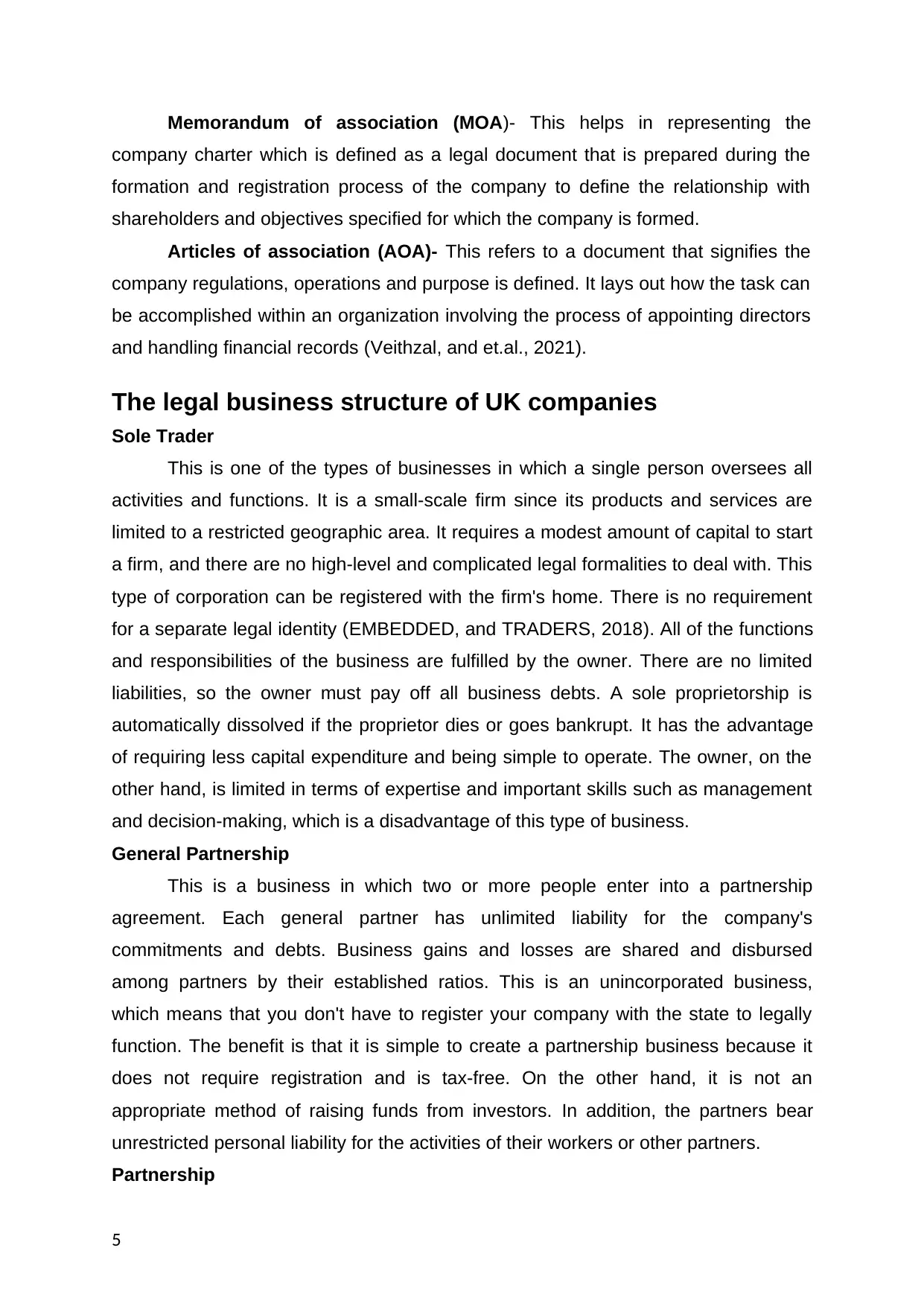
Memorandum of association (MOA)- This helps in representing the
company charter which is defined as a legal document that is prepared during the
formation and registration process of the company to define the relationship with
shareholders and objectives specified for which the company is formed.
Articles of association (AOA)- This refers to a document that signifies the
company regulations, operations and purpose is defined. It lays out how the task can
be accomplished within an organization involving the process of appointing directors
and handling financial records (Veithzal, and et.al., 2021).
The legal business structure of UK companies
Sole Trader
This is one of the types of businesses in which a single person oversees all
activities and functions. It is a small-scale firm since its products and services are
limited to a restricted geographic area. It requires a modest amount of capital to start
a firm, and there are no high-level and complicated legal formalities to deal with. This
type of corporation can be registered with the firm's home. There is no requirement
for a separate legal identity (EMBEDDED, and TRADERS, 2018). All of the functions
and responsibilities of the business are fulfilled by the owner. There are no limited
liabilities, so the owner must pay off all business debts. A sole proprietorship is
automatically dissolved if the proprietor dies or goes bankrupt. It has the advantage
of requiring less capital expenditure and being simple to operate. The owner, on the
other hand, is limited in terms of expertise and important skills such as management
and decision-making, which is a disadvantage of this type of business.
General Partnership
This is a business in which two or more people enter into a partnership
agreement. Each general partner has unlimited liability for the company's
commitments and debts. Business gains and losses are shared and disbursed
among partners by their established ratios. This is an unincorporated business,
which means that you don't have to register your company with the state to legally
function. The benefit is that it is simple to create a partnership business because it
does not require registration and is tax-free. On the other hand, it is not an
appropriate method of raising funds from investors. In addition, the partners bear
unrestricted personal liability for the activities of their workers or other partners.
Partnership
5
company charter which is defined as a legal document that is prepared during the
formation and registration process of the company to define the relationship with
shareholders and objectives specified for which the company is formed.
Articles of association (AOA)- This refers to a document that signifies the
company regulations, operations and purpose is defined. It lays out how the task can
be accomplished within an organization involving the process of appointing directors
and handling financial records (Veithzal, and et.al., 2021).
The legal business structure of UK companies
Sole Trader
This is one of the types of businesses in which a single person oversees all
activities and functions. It is a small-scale firm since its products and services are
limited to a restricted geographic area. It requires a modest amount of capital to start
a firm, and there are no high-level and complicated legal formalities to deal with. This
type of corporation can be registered with the firm's home. There is no requirement
for a separate legal identity (EMBEDDED, and TRADERS, 2018). All of the functions
and responsibilities of the business are fulfilled by the owner. There are no limited
liabilities, so the owner must pay off all business debts. A sole proprietorship is
automatically dissolved if the proprietor dies or goes bankrupt. It has the advantage
of requiring less capital expenditure and being simple to operate. The owner, on the
other hand, is limited in terms of expertise and important skills such as management
and decision-making, which is a disadvantage of this type of business.
General Partnership
This is a business in which two or more people enter into a partnership
agreement. Each general partner has unlimited liability for the company's
commitments and debts. Business gains and losses are shared and disbursed
among partners by their established ratios. This is an unincorporated business,
which means that you don't have to register your company with the state to legally
function. The benefit is that it is simple to create a partnership business because it
does not require registration and is tax-free. On the other hand, it is not an
appropriate method of raising funds from investors. In addition, the partners bear
unrestricted personal liability for the activities of their workers or other partners.
Partnership
5
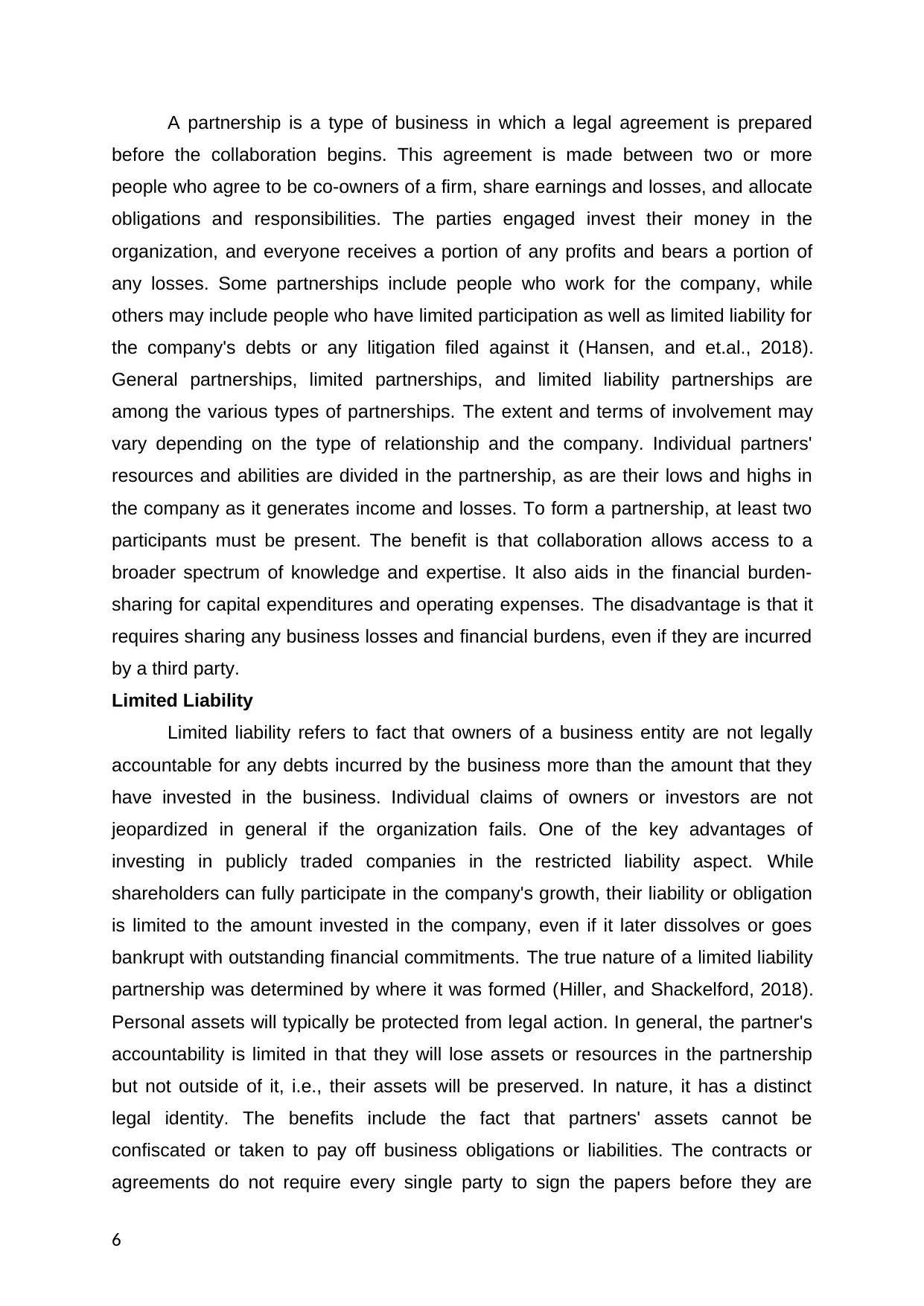
A partnership is a type of business in which a legal agreement is prepared
before the collaboration begins. This agreement is made between two or more
people who agree to be co-owners of a firm, share earnings and losses, and allocate
obligations and responsibilities. The parties engaged invest their money in the
organization, and everyone receives a portion of any profits and bears a portion of
any losses. Some partnerships include people who work for the company, while
others may include people who have limited participation as well as limited liability for
the company's debts or any litigation filed against it (Hansen, and et.al., 2018).
General partnerships, limited partnerships, and limited liability partnerships are
among the various types of partnerships. The extent and terms of involvement may
vary depending on the type of relationship and the company. Individual partners'
resources and abilities are divided in the partnership, as are their lows and highs in
the company as it generates income and losses. To form a partnership, at least two
participants must be present. The benefit is that collaboration allows access to a
broader spectrum of knowledge and expertise. It also aids in the financial burden-
sharing for capital expenditures and operating expenses. The disadvantage is that it
requires sharing any business losses and financial burdens, even if they are incurred
by a third party.
Limited Liability
Limited liability refers to fact that owners of a business entity are not legally
accountable for any debts incurred by the business more than the amount that they
have invested in the business. Individual claims of owners or investors are not
jeopardized in general if the organization fails. One of the key advantages of
investing in publicly traded companies in the restricted liability aspect. While
shareholders can fully participate in the company's growth, their liability or obligation
is limited to the amount invested in the company, even if it later dissolves or goes
bankrupt with outstanding financial commitments. The true nature of a limited liability
partnership was determined by where it was formed (Hiller, and Shackelford, 2018).
Personal assets will typically be protected from legal action. In general, the partner's
accountability is limited in that they will lose assets or resources in the partnership
but not outside of it, i.e., their assets will be preserved. In nature, it has a distinct
legal identity. The benefits include the fact that partners' assets cannot be
confiscated or taken to pay off business obligations or liabilities. The contracts or
agreements do not require every single party to sign the papers before they are
6
before the collaboration begins. This agreement is made between two or more
people who agree to be co-owners of a firm, share earnings and losses, and allocate
obligations and responsibilities. The parties engaged invest their money in the
organization, and everyone receives a portion of any profits and bears a portion of
any losses. Some partnerships include people who work for the company, while
others may include people who have limited participation as well as limited liability for
the company's debts or any litigation filed against it (Hansen, and et.al., 2018).
General partnerships, limited partnerships, and limited liability partnerships are
among the various types of partnerships. The extent and terms of involvement may
vary depending on the type of relationship and the company. Individual partners'
resources and abilities are divided in the partnership, as are their lows and highs in
the company as it generates income and losses. To form a partnership, at least two
participants must be present. The benefit is that collaboration allows access to a
broader spectrum of knowledge and expertise. It also aids in the financial burden-
sharing for capital expenditures and operating expenses. The disadvantage is that it
requires sharing any business losses and financial burdens, even if they are incurred
by a third party.
Limited Liability
Limited liability refers to fact that owners of a business entity are not legally
accountable for any debts incurred by the business more than the amount that they
have invested in the business. Individual claims of owners or investors are not
jeopardized in general if the organization fails. One of the key advantages of
investing in publicly traded companies in the restricted liability aspect. While
shareholders can fully participate in the company's growth, their liability or obligation
is limited to the amount invested in the company, even if it later dissolves or goes
bankrupt with outstanding financial commitments. The true nature of a limited liability
partnership was determined by where it was formed (Hiller, and Shackelford, 2018).
Personal assets will typically be protected from legal action. In general, the partner's
accountability is limited in that they will lose assets or resources in the partnership
but not outside of it, i.e., their assets will be preserved. In nature, it has a distinct
legal identity. The benefits include the fact that partners' assets cannot be
confiscated or taken to pay off business obligations or liabilities. The contracts or
agreements do not require every single party to sign the papers before they are
6
⊘ This is a preview!⊘
Do you want full access?
Subscribe today to unlock all pages.

Trusted by 1+ million students worldwide
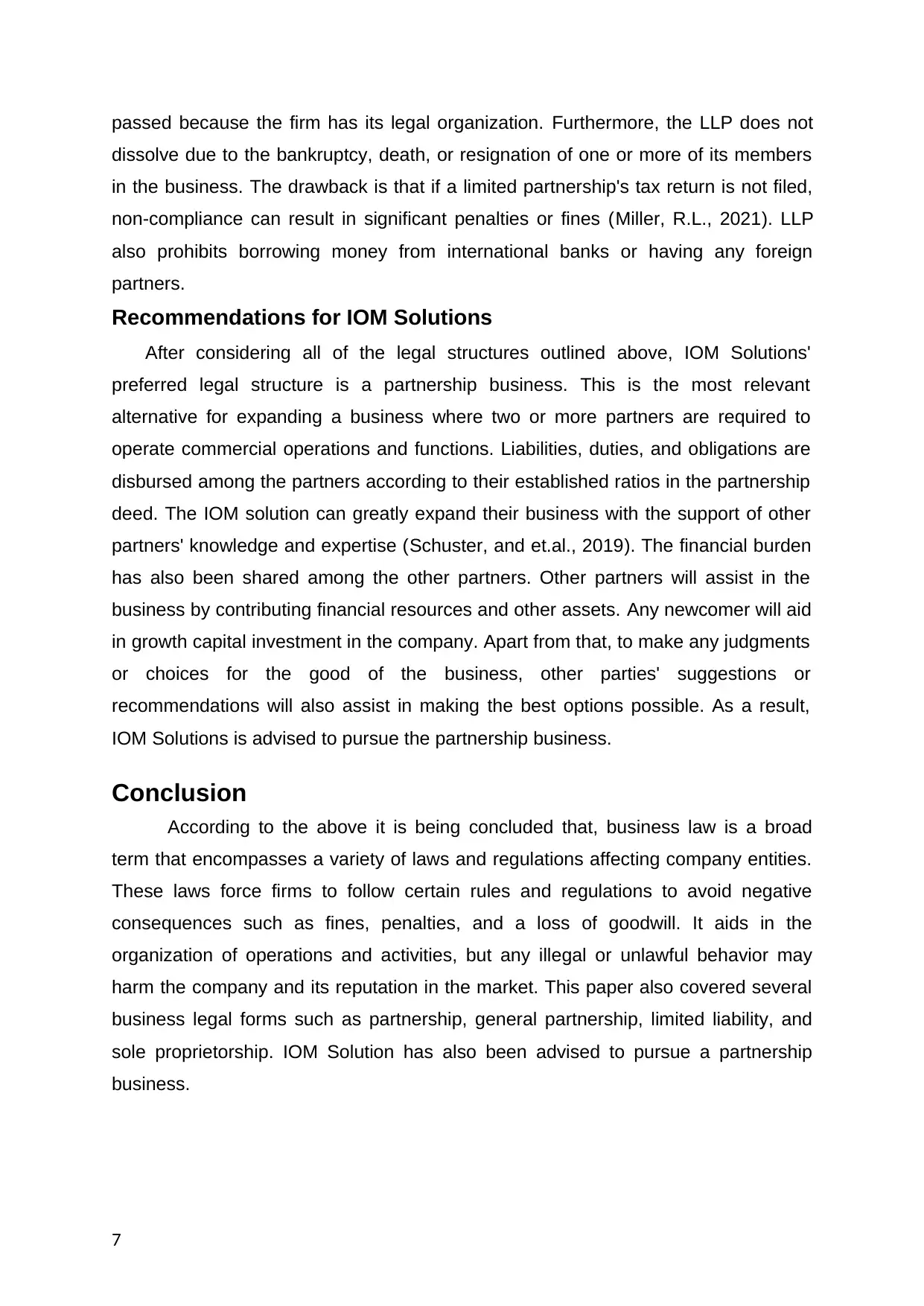
passed because the firm has its legal organization. Furthermore, the LLP does not
dissolve due to the bankruptcy, death, or resignation of one or more of its members
in the business. The drawback is that if a limited partnership's tax return is not filed,
non-compliance can result in significant penalties or fines (Miller, R.L., 2021). LLP
also prohibits borrowing money from international banks or having any foreign
partners.
Recommendations for IOM Solutions
After considering all of the legal structures outlined above, IOM Solutions'
preferred legal structure is a partnership business. This is the most relevant
alternative for expanding a business where two or more partners are required to
operate commercial operations and functions. Liabilities, duties, and obligations are
disbursed among the partners according to their established ratios in the partnership
deed. The IOM solution can greatly expand their business with the support of other
partners' knowledge and expertise (Schuster, and et.al., 2019). The financial burden
has also been shared among the other partners. Other partners will assist in the
business by contributing financial resources and other assets. Any newcomer will aid
in growth capital investment in the company. Apart from that, to make any judgments
or choices for the good of the business, other parties' suggestions or
recommendations will also assist in making the best options possible. As a result,
IOM Solutions is advised to pursue the partnership business.
Conclusion
According to the above it is being concluded that, business law is a broad
term that encompasses a variety of laws and regulations affecting company entities.
These laws force firms to follow certain rules and regulations to avoid negative
consequences such as fines, penalties, and a loss of goodwill. It aids in the
organization of operations and activities, but any illegal or unlawful behavior may
harm the company and its reputation in the market. This paper also covered several
business legal forms such as partnership, general partnership, limited liability, and
sole proprietorship. IOM Solution has also been advised to pursue a partnership
business.
7
dissolve due to the bankruptcy, death, or resignation of one or more of its members
in the business. The drawback is that if a limited partnership's tax return is not filed,
non-compliance can result in significant penalties or fines (Miller, R.L., 2021). LLP
also prohibits borrowing money from international banks or having any foreign
partners.
Recommendations for IOM Solutions
After considering all of the legal structures outlined above, IOM Solutions'
preferred legal structure is a partnership business. This is the most relevant
alternative for expanding a business where two or more partners are required to
operate commercial operations and functions. Liabilities, duties, and obligations are
disbursed among the partners according to their established ratios in the partnership
deed. The IOM solution can greatly expand their business with the support of other
partners' knowledge and expertise (Schuster, and et.al., 2019). The financial burden
has also been shared among the other partners. Other partners will assist in the
business by contributing financial resources and other assets. Any newcomer will aid
in growth capital investment in the company. Apart from that, to make any judgments
or choices for the good of the business, other parties' suggestions or
recommendations will also assist in making the best options possible. As a result,
IOM Solutions is advised to pursue the partnership business.
Conclusion
According to the above it is being concluded that, business law is a broad
term that encompasses a variety of laws and regulations affecting company entities.
These laws force firms to follow certain rules and regulations to avoid negative
consequences such as fines, penalties, and a loss of goodwill. It aids in the
organization of operations and activities, but any illegal or unlawful behavior may
harm the company and its reputation in the market. This paper also covered several
business legal forms such as partnership, general partnership, limited liability, and
sole proprietorship. IOM Solution has also been advised to pursue a partnership
business.
7
Paraphrase This Document
Need a fresh take? Get an instant paraphrase of this document with our AI Paraphraser
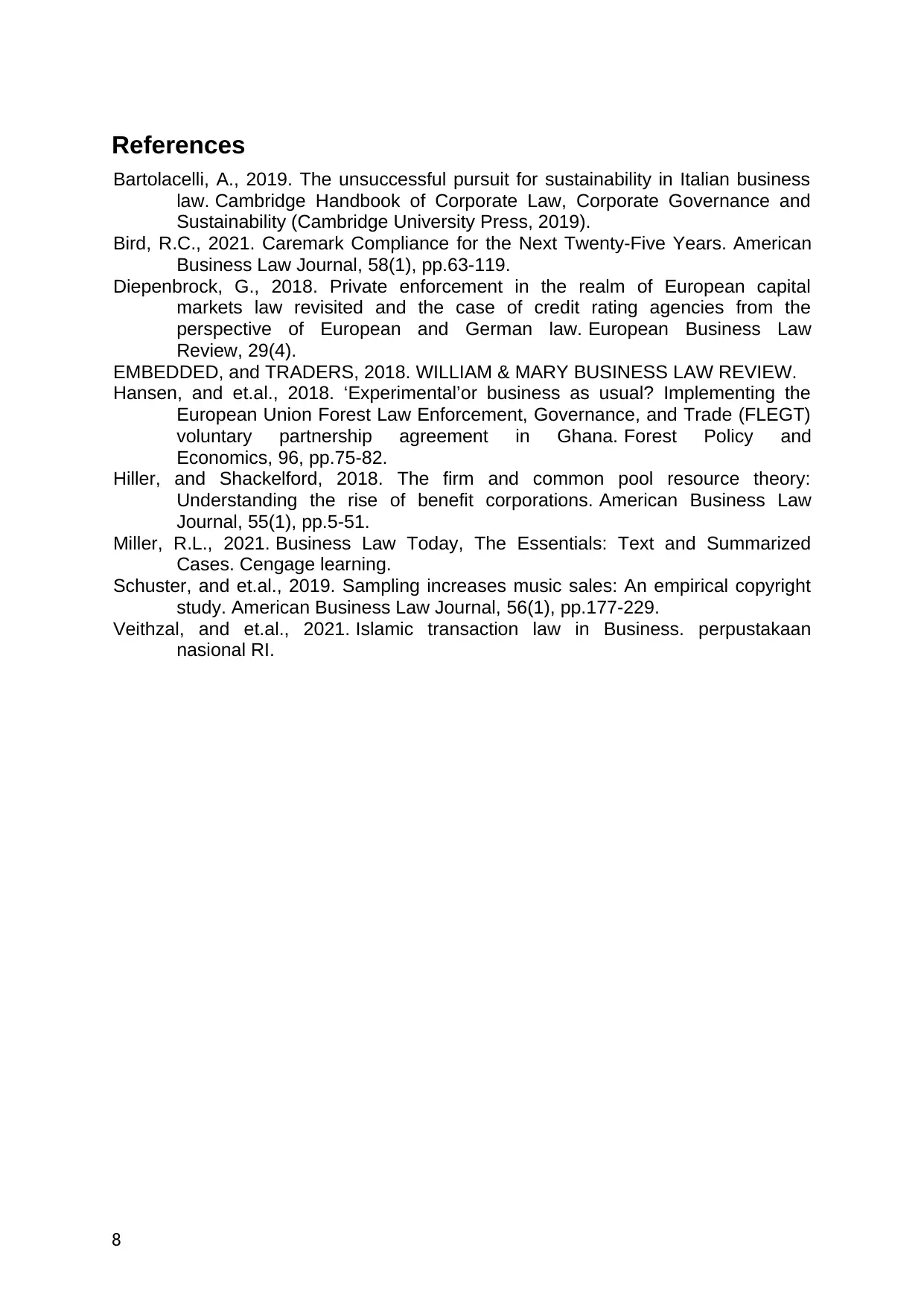
References
Bartolacelli, A., 2019. The unsuccessful pursuit for sustainability in Italian business
law. Cambridge Handbook of Corporate Law, Corporate Governance and
Sustainability (Cambridge University Press, 2019).
Bird, R.C., 2021. Caremark Compliance for the Next Twenty‐Five Years. American
Business Law Journal, 58(1), pp.63-119.
Diepenbrock, G., 2018. Private enforcement in the realm of European capital
markets law revisited and the case of credit rating agencies from the
perspective of European and German law. European Business Law
Review, 29(4).
EMBEDDED, and TRADERS, 2018. WILLIAM & MARY BUSINESS LAW REVIEW.
Hansen, and et.al., 2018. ‘Experimental’or business as usual? Implementing the
European Union Forest Law Enforcement, Governance, and Trade (FLEGT)
voluntary partnership agreement in Ghana. Forest Policy and
Economics, 96, pp.75-82.
Hiller, and Shackelford, 2018. The firm and common pool resource theory:
Understanding the rise of benefit corporations. American Business Law
Journal, 55(1), pp.5-51.
Miller, R.L., 2021. Business Law Today, The Essentials: Text and Summarized
Cases. Cengage learning.
Schuster, and et.al., 2019. Sampling increases music sales: An empirical copyright
study. American Business Law Journal, 56(1), pp.177-229.
Veithzal, and et.al., 2021. Islamic transaction law in Business. perpustakaan
nasional RI.
8
Bartolacelli, A., 2019. The unsuccessful pursuit for sustainability in Italian business
law. Cambridge Handbook of Corporate Law, Corporate Governance and
Sustainability (Cambridge University Press, 2019).
Bird, R.C., 2021. Caremark Compliance for the Next Twenty‐Five Years. American
Business Law Journal, 58(1), pp.63-119.
Diepenbrock, G., 2018. Private enforcement in the realm of European capital
markets law revisited and the case of credit rating agencies from the
perspective of European and German law. European Business Law
Review, 29(4).
EMBEDDED, and TRADERS, 2018. WILLIAM & MARY BUSINESS LAW REVIEW.
Hansen, and et.al., 2018. ‘Experimental’or business as usual? Implementing the
European Union Forest Law Enforcement, Governance, and Trade (FLEGT)
voluntary partnership agreement in Ghana. Forest Policy and
Economics, 96, pp.75-82.
Hiller, and Shackelford, 2018. The firm and common pool resource theory:
Understanding the rise of benefit corporations. American Business Law
Journal, 55(1), pp.5-51.
Miller, R.L., 2021. Business Law Today, The Essentials: Text and Summarized
Cases. Cengage learning.
Schuster, and et.al., 2019. Sampling increases music sales: An empirical copyright
study. American Business Law Journal, 56(1), pp.177-229.
Veithzal, and et.al., 2021. Islamic transaction law in Business. perpustakaan
nasional RI.
8
1 out of 8
Related Documents
Your All-in-One AI-Powered Toolkit for Academic Success.
+13062052269
info@desklib.com
Available 24*7 on WhatsApp / Email
![[object Object]](/_next/static/media/star-bottom.7253800d.svg)
Unlock your academic potential
Copyright © 2020–2025 A2Z Services. All Rights Reserved. Developed and managed by ZUCOL.

